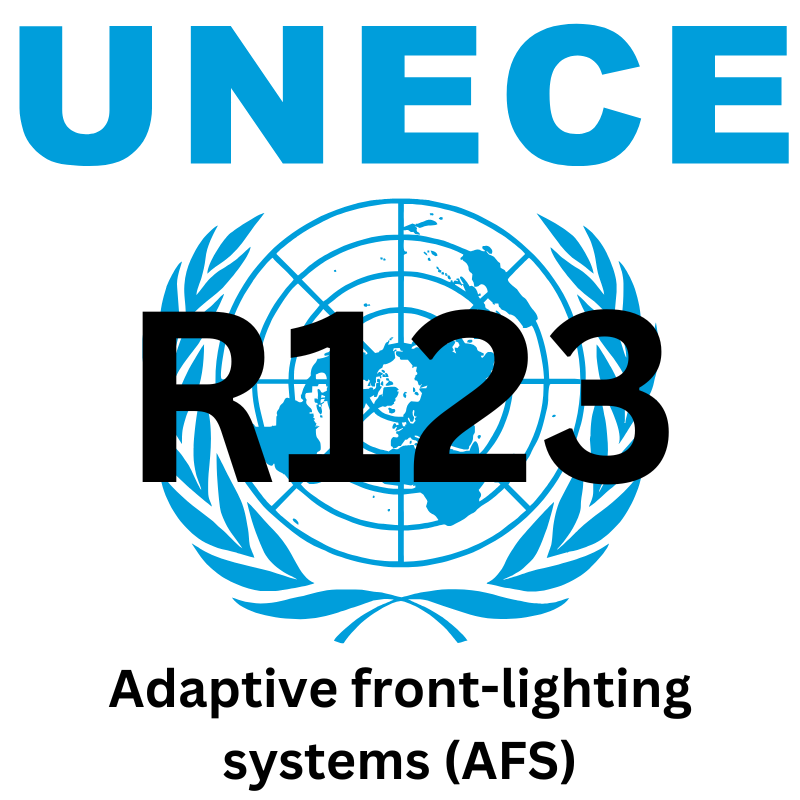Guide To: UNECE R123 - Adaptive front-lighting systems (AFS)
24 October 2024

Guide To: UNECE R123 - Adaptive front-lighting systems (AFS)
UN ECE Regulation No. 123 establishes uniform provisions for the approval of adaptive front-lighting systems (AFS) for motor vehicles. AFS technology allows vehicle headlamps to automatically adjust their beam patterns based on various driving conditions, enhancing road safety by optimizing visibility without dazzling other road users. These systems can adapt the light distribution for different environments, such as urban areas, highways, and bends, improving driver safety and comfort.
Scope of the Regulation
UN ECE Regulation No. 123 applies to:
- Adaptive front-lighting systems (AFS) for vehicles in categories M (passenger cars) and N (goods vehicles). These systems adjust the passing-beam (low beam) and, in some cases, the driving-beam (high beam) to improve visibility based on factors like vehicle speed, steering angle, and ambient lighting.
Key Features of UN ECE Regulation No. 123
Design and Construction:
- AFS systems consist of various components, including system control units, lighting units, and optical devices. These parts work together to adjust the beam patterns automatically, providing better visibility in different driving conditions, such as sharp curves, motorways, and adverse weather.
- The regulation requires AFS to provide a Class C passing-beam, as well as additional beam classes (V, E, W) for specific driving conditions. Each beam class is optimized for particular environments like urban areas (Class V), motorways (Class E), or wet roads (Class W).
Illumination and Photometric Requirements:
- AFS must meet stringent photometric standards to ensure that they provide sufficient illumination in all modes of operation without causing glare. The regulation outlines specific performance criteria for each beam class and mode, ensuring that the light is directed appropriately and consistently.
- The system must be capable of automatic beam adaptation for changing conditions, such as bends or vehicle speed adjustments. This ensures that drivers have optimal visibility regardless of the environment.
Bending Mode:
- One of the key features of AFS is the bending mode, where the headlamp beam is adjusted laterally to illuminate the road when the vehicle is turning. This feature is designed to improve safety on curves and at intersections.
Marking and Approval:
- AFS systems must carry approval markings to indicate compliance with UN ECE Regulation No. 123. These markings include the manufacturer’s trade name or mark and other approval symbols specific to the system’s functions.
UN ECE Regulation No. 123 has been incorporated into UN ECE Regulation No. 149, which governs road illumination devices. Regulation No. 149 consolidates multiple lighting-related regulations, streamlining the technical standards for various vehicle lighting systems, including adaptive front-lighting systems (AFS), headlamps, and cornering lamps. The goal of this consolidation is to simplify the regulatory framework for manufacturers, making it easier to comply with international standards.
By consolidating AFS requirements into Regulation No. 149, the approval process for advanced lighting systems is simplified, enabling manufacturers to meet global safety standards while integrating modern technologies like LED modules and adaptive beams.
Conclusion
UN ECE Regulation No. 123 establishes vital safety standards for adaptive front-lighting systems, ensuring that they provide effective and safe illumination under various driving conditions. With the regulation’s incorporation into UN ECE Regulation No. 149, the industry benefits from a more unified framework governing all road illumination devices. This consolidation supports the global adoption of advanced lighting technologies while maintaining strict safety requirements for vehicles.